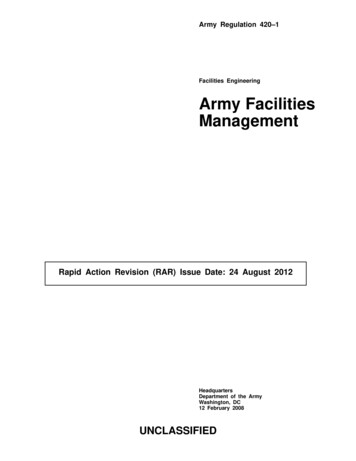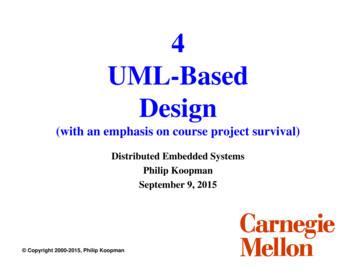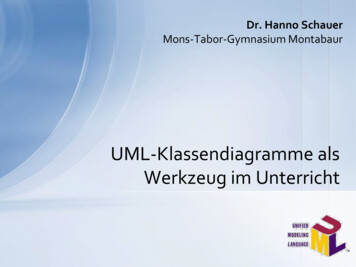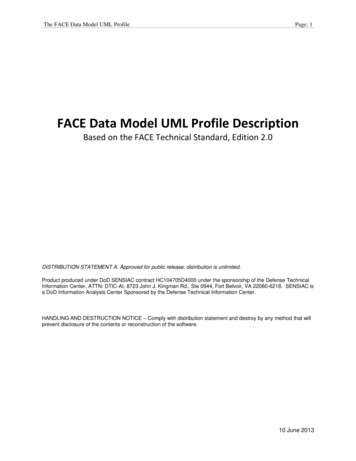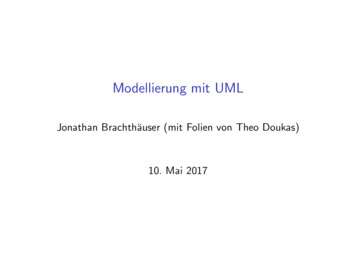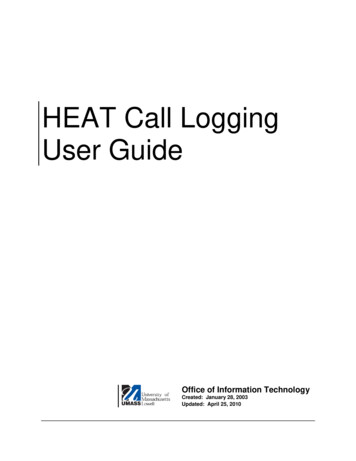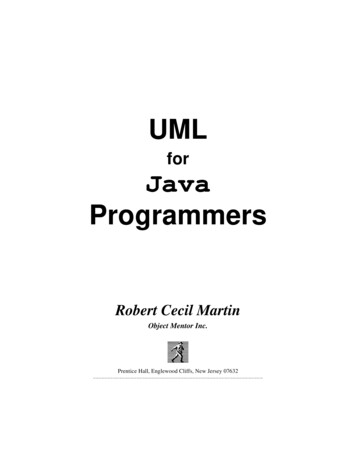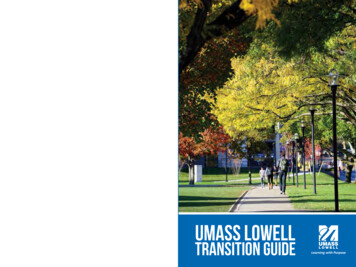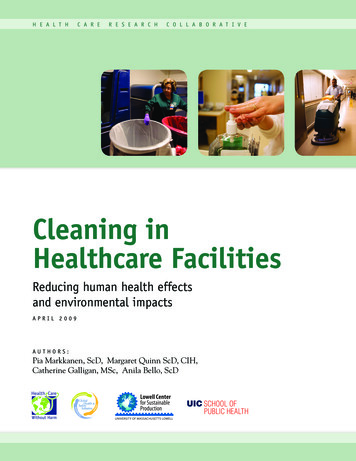
Transcription
H E A L T HC A R ER E S E A R C HC O L L A B O R A T I V ECleaning inHealthcare FacilitiesReducing human health effectsand environmental impactsAPRIL 2009AUTHORS:Pia Markkanen, ScD, Margaret Quinn ScD, CIH,Catherine Galligan, MSc, Anila Bello, ScD
Health Care Without Harmhas initiated a researchcollaborative coordinatedby faculty of the Universityof Illinois at Chicago Schoolof Public Health, withsupport from the PioneerPortfolio of the Robert WoodJohnson Foundation, aimedat stimulating collaborativeresearch around health andsafety improvements inhealth care. This collaborativeis designed to increase theevidence base concerningthe human health andenvironmental impacts ofmaterials, products andpractices within healthcare. In partnership withthe Global Health and SafetyInitiative (GHSI), the ResearchCollaborative is engagedin research directed at theintersection of environmental,patient, and worker safetyissues related to buildingand operating health careinstitutions.This paper is part of a seriesin which the Collaborativewill provide research andanalysis of the health andenvironmental impacts ofselect groups of this newgeneration of materials andfacilitate sharing of experienceson installation, maintenanceand performance.
TA B L E O F C O N T E N T SAcknowledgements.2Executive Summary.3I.Introduction.6II.Purpose and development of this document .7III.Background.8Definitions for cleaning and disinfection.8Cleaning and potential harms to health and the environment .8Significance of cleaning in the healthcare sector.9The cleaning system.10IV.Health and environmental hazards: scientific and professional evidence .11Human health effects.11Exposure assessment efforts.12Environmental impacts.13V.Healthier and more environmentally friendly cleaning for healthcare.14What is green cleaning?.14Benefits of green cleaning and examples of efforts.14Cleaning, disinfecting, and antimicrobials products.15VI.Systems approach .17SHP experience with a systems approach to changing practices in hospitals.18Practice Greenhealth approach.20Management and the team.20VII. Green movements in the healthcare sector.21LEED for Healthcare.21Green cleaner certification programs.21VIII. Moving upstream towards non-chemical alternatives.23IX.Conclusions and recommendations.25List of references.27Appendix A: Examples of hazardous ingredients in conventional cleaning products .31Appendix B: Information on green cleaning efforts in healthcare facilities.34Appendix C: Selected sources for choosing industrial green cleaning products .36
AcknowledgementsThis paper has been jointly commissioned by HealthCare Without Harm and the Global Health and SafetyInitiative. It has been developed by the research teamat the Sustainable Hospitals Program (SHP), a program of the Lowell Center for Sustainable Production(LCSP) at the University of Massachusetts Lowell. Theauthors gratefully acknowledge the following persons inthe development and review of this document: Cathy Crumbley, Program Director, the LowellCenter for Sustainable Production; Judene Bartley (MSc, MPH, CIC) Vice President ofthe Epidemiology Consulting Services, Inc.This paper was generously funded from the PioneerPortfolio of the Robert Wood Johnson Foundation.Design & Layout by Kieran Daly & Parisa Damian ofWinking Fish.The Sustainable Hospitals ProgramThe Sustainable Hospitals Program (SHP) was initiatedat the University of Massachusetts Lowell in 1998 to provide science-based technical guidance to the healthcareindustry for selecting products and practices that promoteoccupational and environmental health and safety. Basedwithin the Lowell Center for Sustainable Production(LCSP), the SHP aims to fully integrate occupationaland environmental health and safety into comprehensivesolutions for more sustainable healthcare.The SHP and LCSP have a research program to promotesafer and more environmentally sound cleaning materialsand practices. This work has the following components:1. Conducting exposure assessments. Identifyingwhat workers, patients and other building occupants are exposed to is the first step in improvingcleaning. The SHP has an occupational/environmental hygiene laboratory and field equipment andhas developed the technical expertise to measureexposures from cleaning.2. Characterizing the health effects of cleaningproducts. Epidemiologists on our team have experience conducting field studies as well as in con-ducting systematic reviews of the health literature.The LCSP collaborated with Health Care WithoutHarm to write “Risks to Asthma Posed by IndoorHealth Care Environments: A Guide to Identifying and Reducing Problematic Exposures”.13. Assessing the effectiveness of new cleaningproducts. The Surface Solutions Laboratory (SSL)of the LCSP-UMass Lowell sister organization, TheToxic Use Reduction Institute (TURI), conducts efficacy testing on cleaning products and promotes theuse of green cleaners.2-4 TURI offers an interactive,free-of-charge online database on surface cleaning5—called CleanerSolutions—to help manufacturersfind safer cleaning alternatives that perform as wellas the products based on hazardous chemicals. It alsoprovides online information including “Ten Waysto Find Safer and Greener Cleaners”.6 The TURISSL is certified by Green Seal—the US eco-labelingorganization—to test the efficacy of green products.4. Conducting field studies to assist healthcarefacilities in implementing alternative cleaningproducts and practices. Over the past decade,the SHP has used participatory processes for implementing healthier and more sustainable workplaceprograms through the Pollution Prevention-Occupational Safety and Health alternatives assessmentstrategy (P2OSH).75. Translating sound environmental practicesinto social policy and regulations. We work withhealthcare providers and insurers to improve theprovision of environmental remediation for asthmatriggers in the home.8-10 Another example of thetranslation of research to practice is a project witha Brazilian women’s organization to educate Brazilian domestic cleaners about the hazards of household cleaners and help them to replace these withless toxic cleaners made from safer ingredients.11Lowell Center of Sustainable ProductionUniversity of Massachusetts LowellOne University Avenue Lowell, MA 01854978-934-2980www.sustainableproduction.org
EXECUTIVE SUMMARYCleaning of healthcare facilities is performed formedical and cultural reasons. Maintaining anenvironment with a low pathogenic burden isessential for avoiding complications during thecare and recuperation of patients. A healthy,safe, and aesthetically pleasing space with cleansurfaces is comforting to patients and theirfamilies by giving an impression of good qualitycare without additional health hazards.While cleaning is important in all economic sectors, itserves the healthcare industry the dual functions of: (i)surface cleanliness, and (ii) infection prevention andcontrol. As such, healthcare settings require intensiveand frequent cleaning with a wide range of products.This document summarizes the main health andenvironmental impacts related to conventional surfacecleaning, describes a systems approach for designingand implementing healthier and environmentallyfriendlier cleaning strategies for the healthcare sector,and indicates areas where future research and policyinitiatives are needed.Cleaning for infectionprevention and controlImprovements in the health and environmentalimpacts of cleaning must be considered along withconcerns for infection prevention and control. Healthcare settings are engaged in a battle against healthcareassociated infections (HAIs).12 The importance ofinfection prevention and control is increasing dueto rapidly developing strains of multi-drug resistantorganisms (MDROs) that can result in serious illnessand even death in workers and patients. In 2002, UShospitals reported about 1.7 million HAIs, associatedwith almost 99,000 deaths.13 The proportion of S.aureus bloodstream infections due to MRSA increasedsignificantly from 27% in the period of 1990-1994to 54% during 2000-2004 (P .001).13 Studies haveestimated that antimicrobial drug-resistant infectionshave increased direct costs to society by 30%-100%.14The excess cost of a single MRSA infection comparedwith a methicillin-sensitive S. aureus infection wasestimated to range from 3,000 to 25,000.14 This suggests that MRSA costs the healthcare system (patientsand healthcare facilities) an estimated additional 830million to 9.7 billion in 2005—excluding the indirectcosts related to psychological suffering of patients andtheir family members as well as lost work time spent inthe hospital.14Potential health and environmentalimpacts of cleaning chemicalsMany hospitals have increased the use of cleaning anddisinfecting products to address HAIs as well as otherinfection prevention and control concerns. However,conventional cleaning products and disinfectants bringa host of other health hazards despite their capacity to fight against MDROs. This document providesa literature review of cleaning products and theiradverse effects on human health and the environment.Conventional cleaning products are complex mixturesof chemical ingredients. Many of these ingredients areknown or suspected to be associated with asthma andCleaning in healthcare facilities: Reducing human health effects and environmental impacts3
other respiratory disorders. Some others are associatedwith dermatitis, endocrine and neurologic effects, andcancer. However, many ingredients have not beentested and so their effects are still unknown. Potentiallyharmful exposures from cleaning are a function of multiple factors, including: (i) the chemical characteristicsof the cleaning product, (ii) the physical characteristics(aerosols vs. liquids for example), (iii) the characteristics of cleaning tasks (spraying vs. mopping), and (iv)the characteristics of the built environment (ventilation, room size).15 There is evidence that some cleaningproduct ingredients harm the environment. They maybioaccumulate in plants and animals, damage aquaticecosystems, and pollute indoor air, outdoor air, anddrinking water supplies.16Greener cleaningConcerns about adverse human and environmentalhealth effects of conventional cleaning products haveled to the development of “green” cleaners. Some greencleaners may reduce human health and environmental effects as well as reduce costs. However, little isknown about whether green cleaning programs meetor compromise infection control and prevention goals.Interestingly, there is no widely accepted definition of“green” or “green cleaning”. US Executive Order 13101defines “environmentally preferable” as “products orservices that have a lesser or reduced effect on human healthand the environment when compared with competing products or services that serve the same purpose”.17 However,t
Blue Angel in Germany.19 The healthcare sector as a whole is working to develop and implement sustainable and green initiatives, including green cleaning pro-grams. One of the most visible and influential initia-tives is the impending 2009 launch of the new Lead-ership in Energy and Environmental Design (LEED) certification program tailored for the healthcare indus-try.20 One of the issues it .
